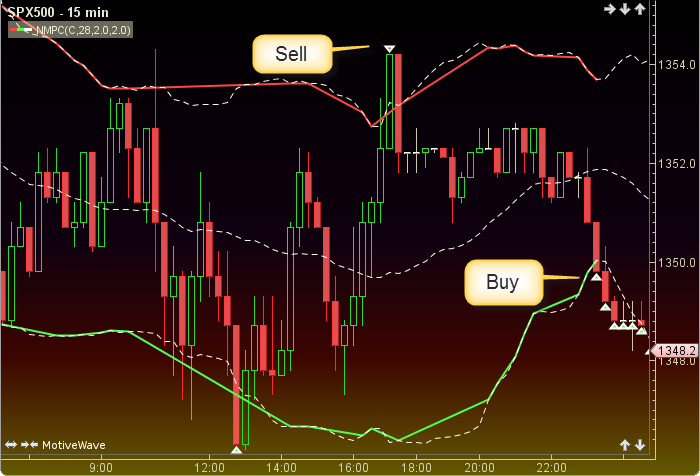New Market Paradigm Contraction
The New Market Paradigm Contraction was authored by Walter T. Downs in the Stocks and Commodities Magazine 06/1998. This indcator uses the current and previous Bollinger Bands®, along with some conditional statements, to plot its paths. The user may change the input (close), period length and standard deviation values. This indicator’s definition is further expressed in the condensed code given in the calculation below.

How To Trade Using New Market Paradigm Contraction
Adjust the Standard Deviation and period length to control the quantity and quality on the trading signals. If the price is above the top band a sell signal will be generated. Conversely, if the price is below the bottom band a buy signal will be given.

How To Access in MotiveWave
Go to the top menu, choose Study>Bands>New Market Paradigm Contraction
or go to the top menu, choose Add Study, start typing in this study name until you see it appear in the list, click on the study name, click OK.
Important Disclaimer: The information provided on this page is strictly for informational purposes and is not to be construed as advice or solicitation to buy or sell any security. Please see our Risk Disclosure and Performance Disclaimer Statement.
Calculation
//input = price, user defined, default is close
//period = user defined, default is 28
//sdUp = standard deviation up, user defined, default is 2
//sdDn = standard deviation down, user defined, default is 2
//bb = bollinger bands, sma = simple moving average, prev = previous
//bb[0] = bb top, bb[1] = bb bottom, bb[2] = bb sma
//index = current bar number
nmP = 0;
bb[] = bollingerBands(index, period, sdUp, sdDn, input);
prevBb[] = bollingerBands(index-1, period, sdUp, sdDn, input);
top = bb[0];
bott = bb[1];
cond1 = top lessThan prevBb[0] AND bott moreThan prevBb[1];
cond2 = top moreThan prevBb[0] AND bott lessThan prevBb[1];
cond3 = (cond1 == false) AND (cond2 == false);
if (cond1) nmP = 1;
if (cond2) nmP = 2;
if (cond3) nmP = 3;
up = null;
down = null;
if (nmP == 1)
up = top;
down = bott;
endIf
Plot1: up;
Plot2: down;
Plot3: top;
Plot4: bott;
Plot5: bb[2]);
//Signals
sell = price moreThan bb[0];
buy = price lessThan bb[1];
